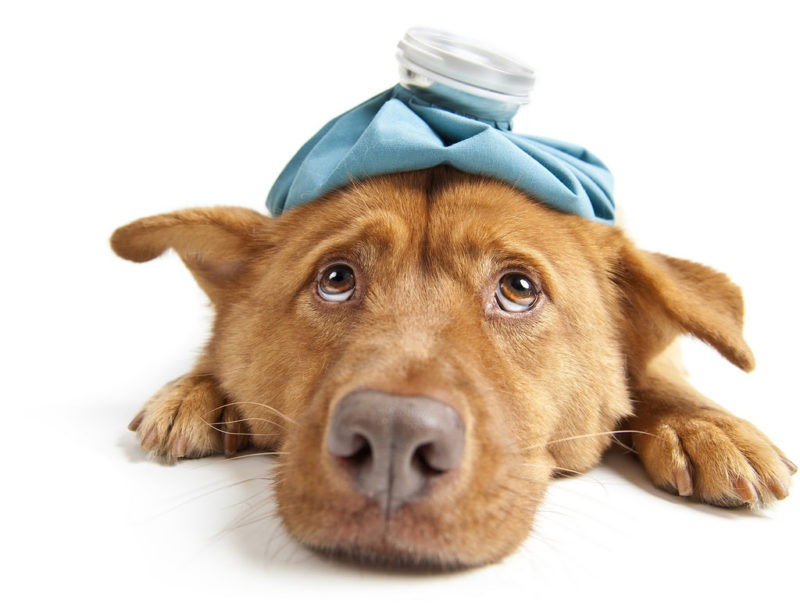Most dogs spend more time outside during the summer than they do during the rest of the year. Going to the beach, hiking, or simply hanging out in the backyard is great fun but also increases a dog’s risk of accidents and injuries. Knowing these summer health hazards will help you avoid many of them. Understanding how to provide first aid will save you time and anxiety if your dog does get hurt.
For life-threatening injuries, your priority is to get your dog to a vet as quickly as possible. Take the time now to make an emergency contact list that includes your vet’s phone number and office hours, the nearest veterinary emergency clinic’s phone number and address, and the ASPCA Animal Poison Control Center’s phone number (888-426-4435).

Common Summer Health Hazards
…And how to start treatment for them.
Just remember that you shouldn’t try to fix everything yourself—call your vet, or bring your dog to the emergency clinic, if you have the slightest concern that everything is not OK.
Heatstroke. A dog who has overheated will pant excessively or struggle to breathe and may be unable to stand or walk. If you suspect a dog is experiencing heatstroke, move him into the shade or an air-conditioned room and wipe down his body repeatedly with a towel soaked in cool water. If his tongue or gums are dark-red or bluish, he is not getting enough oxygen, and you should transport him to a veterinary hospital as quickly as possible. Do not try to blow air into his mouth or nose—this will just panic him further, and he may bite you.
Dogs control their body temperature by panting. If a dog’s breathing is impaired for any reason, he is more likely to overheat. Dogs with pushed-in faces, such as English Bulldogs and Pugs, are structurally unable to breathe, pant, and cool themselves as well as dogs with bigger nasal passages and tracheas, so their time outside should be limited to short bathroom breaks during very hot or humid weather.
Insect bites and stings. If your dog suddenly cries out and starts biting at his foot, or if he has a painful bump or swelling on his skin, a bug bite or sting is a possibility. Give him 1 to 2 milligrams of Benadryl (diphenhydramine) per pound of his body weight every 8 hours for a day or two, and hold a cool, wet washcloth on the bump for a couple of minutes a few times a day. (Adult-strength Benadryl comes in 25 mg capsules. Children’s tablets contain 12.5 mg.)
Some dogs, like some people, are severely allergic to certain insects, and their faces will swell up or they will have trouble breathing if they are stung. If this should happen to your dog, give him Benadryl and rush him to the nearest vet for further treatment.
Drowning. Most dogs can swim, and many enjoy it, but watch them as closely as you would a toddler when they are around a swimming pool, lake, or other body of water. Even a good swimmer can tire and be unable to make it to shore or climb out of a pool.
If a dog is struggling or unconscious in the water, get him out as quickly as you can without putting yourself or anyone else in danger. If possible, once he’s out of the water, hold his hind end higher than his front end for a minute or two and gently thump the sides of his ribcage to help drain water from his nose, mouth, and lungs. Even if his breathing seems to return to normal quickly, it’s still best to take him to a veterinary clinic, because lung damage from inhaled water may not be obvious immediately.
Burned feet. Dogs’ feet are tough, but they’re not tough enough to withstand 120-degree asphalt or playing fetch for hours on an abrasive surface. If sand or pavement is too hot for you to stand on or too rough for you to run on barefoot, then keep your dog off it as well. What should you do if the bottoms of your dog’s feet get burned or skinned accidentally? Have him stand in cool water with some Epsom salts added for a couple of minutes a couple of times a day. Don’t apply any ointment or other medication to his feet, because he’ll just lick it off. Walk him on only soft grass until his feet heal. And ask your vet whether pain medication or antibiotics are needed.
Hotspots. A hotspot is an oozing sore that a dog creates himself by biting, scratching, or licking an area that itches or hurts. Owners usually don’t see the initial problem, and so they are surprised by the sudden appearance of a red, raw, hairless patch on their dog’s skin. It’s fine to start treating a hotspot at home, but be forewarned that oral antibiotics and anti-inflammatories may be required to heal it completely.
Using an electric hair clipper, trim all hair away from the wound and 1 to 2 inches around it on all sides. Then gently blot or wipe the wound with clean gauze or a paper towel dipped in a dilute solution of mild soap and water. Don’t use hydrogen peroxide, rubbing alcohol, or any other disinfectant—they can kill healthy skin cells as well as bacteria. Apply a little antibiotic cream or spray to the wound. Finally, and most important of all, put an Elizabethan collar or T-shirt on your dog to keep him from continuing to scratch or lick the wound, because it will never heal if he keeps worrying at it.
Other wounds. Control bleeding by applying pressure with a pad of paper towels or cloth. Don’t be in a hurry to remove the pad—that may simply open up the wound again. For a leg wound, run any kind of tape around the pad and the dog’s leg to hold it in place while you get him to the vet. Don’t apply a tourniquet unless you think the dog is bleeding to death.
For bite wounds, clip and clean as for a hotspot. Bite wounds often get infected, so have a vet check them out within a day or two. If your dog was bitten by an unknown or potentially rabid animal, such as a raccoon or skunk, he may also need a rabies vaccine booster.
For more tips to keep your pet healthy, happy, and active, check out The Complete Healthy Dog Handbook.





No Comments